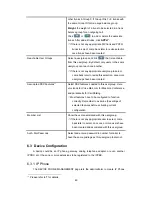
58
#
If selecting Phone Number, enter a number to
which incoming calls are forwarded
unconditionally. The number could be an
extension or a PSTN number with appropriate
outbound prefix.
Unavailable Call Forward
(Optional) Enter a number
to which incoming calls are
forwarded when not answered. The number could be
an extension or a PSTN number with appropriate
outbound prefix.
Timeout to Next Forward
(Optional) Enter a period of time in seconds for ringing
the extension in Unavailable Call Forward. Click
to add the extension in Unavailable Call
Forward and the time here into the list. Remove the
extension of Unavailable Call Forward from the list by
clicking
.
#
The time must be shorter than
Unavailable
Timeout
, or the function will not work normally.
Play Unavailable/Line-in-use
Forward Prompt
(Optional) Notify the caller that callee is not available
and the call is being forwarded to another extension.
Line-in-use Forward
(Optional) Enter a number
to which incoming calls are
forwarded when the extension is busy. The number
could be an extension or a PSTN number with
appropriate outbound prefix.
Selective Call Forward
(Optional) Unconditional call forwarding according to
the calling number. Enters one or more calling
numbers and a forwarding number, and click
.
E.g., forward only calls from 101 to a cellular number,
while let the rest enter the voice mail by default.
Selects a forwarding and click
when the
forwarding is no longer required.
6.4 Route Configuration
A route is a destination number pattern for outbound call matching. A pattern consists of
digits 0-9 (including “-”), “*”, “#”, digit set, and wildcard characters like “.”, “X”, “Z”, and “N”.
Table 6.4
explains digit set and wildcard characters.
Note:
The “#” in route pattern is for some PSTN saver lines that may set “#” as their dial
Summary of Contents for PBX10 FICHE
Page 1: ...SMCPBX10 TigerVoIP IP PBX Telephony System USER GUIDE TM...
Page 2: ......
Page 132: ...SMCPBX10...































